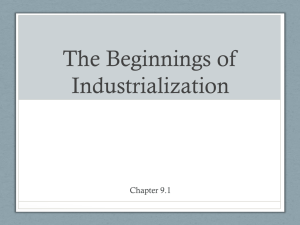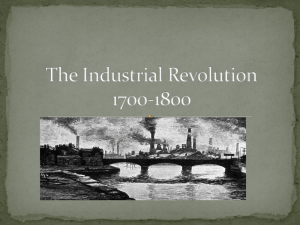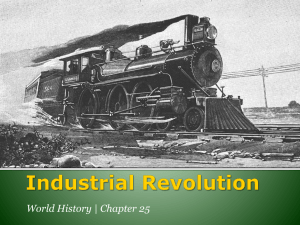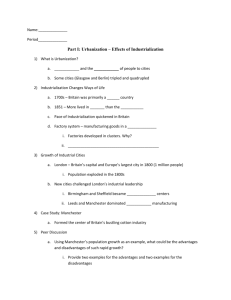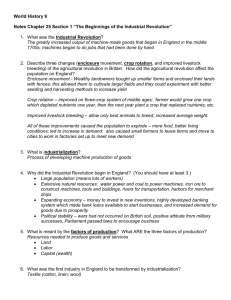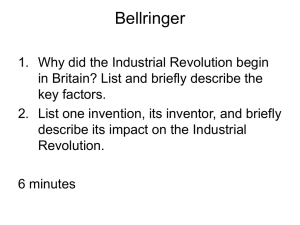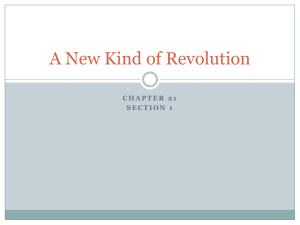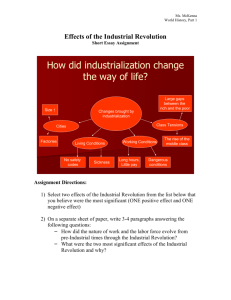Impact of Industrialization and Urbanization
advertisement
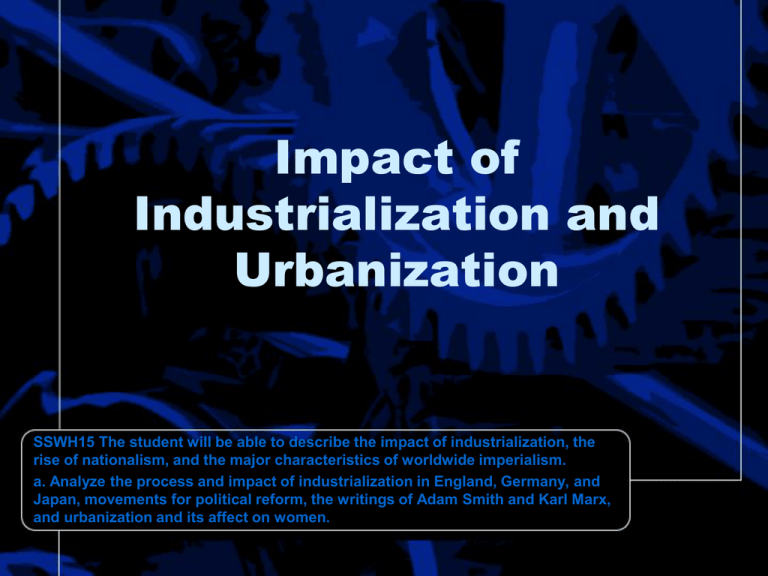
Impact of Industrialization and Urbanization SSWH15 The student will be able to describe the impact of industrialization, the rise of nationalism, and the major characteristics of worldwide imperialism. a. Analyze the process and impact of industrialization in England, Germany, and Japan, movements for political reform, the writings of Adam Smith and Karl Marx, and urbanization and its affect on women. The Industrial Revolution • Began in Great Britain in the 1780’s and took several decades to spread to other Western nations • Several factors contributed to make GB the starting place – Changes in agriculture & increased food supply – Increased population – Ready supply of money to invest – Plentiful natural resources – Supply of markets for manufactured goods Changes in Cotton Production • In 18th century, cotton was made by individuals in their homes • A series of technological advances including the spinning jenny, water powered loom, and steam engine made this inefficient. • In 1760, Britain imported 2.5 million pounds of raw cotton to produce cloth • By 1840, Britain imported 366 million pounds each year Coal & Iron Industries • Steam engine crucial to Britain’s industrial revolution • Engine depended on coal which led to an expansion in coal production • Natural resources included large supplies of iron ore • Burned away impurities on crude iron to improve the quality Railroads • Particularly important to the success of the Revolution • 1804 – first steam powered locomotive • By 1850 able to reach 50 mph and more than 6000 miles of railroad tracks crisscrossed Great Britain • Building railroads meant new jobs for farm laborers and peasants • Less expensive transportation meant larger markets, more sales, more factories, and more machinery. New Factories • Another important element in the Industrial Revolution • This new labor system led to shift work • Early workers came from rural areas so employers had to create a system of work discipline. Spread of Industrialization • By mid nineteenth century, GB had become the world’s first and richest industrial nation • They produced one half of the world’s coal and manufactured goods • Spread to the rest of Europe at different times and speeds • Belgium, France, and the German states were the first to be industrialized • By 1850, a network of railroads spread across Europe Social Impact in Europe • Industrial Revolution changed the social life of Europe and the world • Change was evident in the growth of cities and the emergence of two new social classes– The Industrial Middle Class – The Industrial Working Class Growth of Population & Cities • In 1750, population in Europe was approximately 140 million • By 1850, it had grown to 266 million • Over 50% lived in towns & cities • Led to pitiful living conditions which would prompt urban reformers in the second half of the century Industrial Middle Class • The Industrial Revolution led to industrial capitalism, an economic system based on industrial production • Industrial middle class were made up of the people who built factories, bought the machines, and figured out where the markets were Industrial Working Class • Wretched working conditions • Work hours 12- 16 hrs/ 6 days a week • No minimum wage • Worst conditions in the cotton millsdirty, dangerous, and unhealthy • In coal mines dangerous conditions including cave ins, explosions, and gas fumes were a way of life Impact on Women & Children • By 1830 in Britain, women & children made up 2/3 of the cotton industry’s work force • Factory act of 1833, set 9 as the minimum age and limited hours a child could work • As children declined, women would make up 50% of the labor force by 1870 • Paid half or less than half of men’s wages. • Eventually, laws that limited work hours of women & children would lead to a new pattern of work. Men outside the home and women at low paying jobs in the home. Early Socialism • System in which society, usually in the form of the government, owns and controls some means of the production, such as factories & utilities • Early socialism believed in the equality of all people & wanted to replace competition with cooperation in industry • Later socialists, such as the followers of Karl Marx, labeled earlier theorists as utopian socialists Karl Marx • 1848, The Communist Manifesto, was published. • Written by two Germans, Karl Marx and Friedrich Engels, who were appalled at the horrible working conditions in factories • Blamed industrial capitalism • Felt the working class- the proletariat- would overthrow the oppressors- the middle class and form a dictatorship • Believed this revolution would result in a classless society New Urban Environment • By the end of the 19th century, new industrial world led to the emergence of a mass society in which the concerns of the lower classes were central • By 1890, urban dwellers increased to 60% in England • Cities also grew because living conditions improved Reforms • Boards of health were formed • Building inspectors required new regulations such as running water & internal drainage systems • Gas heaters made hot baths available • Sewer systems were built to dispose of waster Impact of Urbanization on Women • New job opportunities in industrial plants, retail shops, government services, education, health, and social services. • Decline in the birth rate • By 1840’s and 50’s, the women’s movement expanded from earning property rights, access to universities and jobs, into political life and the right to vote. • Between 1890 and 1914, family patterns began to change as working class mothers could afford to stay at home with their children rather than working
